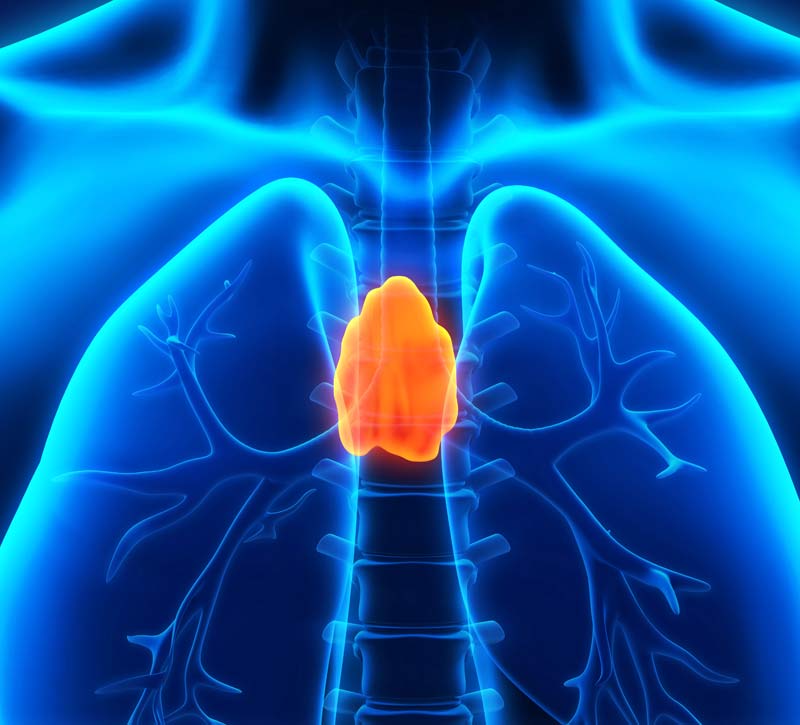The thymus: anatomy, functions, diseases

How is the thymus constructed? What functions does it have in the body? What is its importance for improving the functioning of the immune system? When and why does it disappear? See what you should know about this unusual organ and the role it plays.
The word thymus comes from the Greek “thumos” meaning “soul”, which the Greeks believed resided in this gland.
Structure of the thymus
The thymus is the centrally located lymphatic organ. It is an unpaired organ found in the front of the mediastinum, i.e. in the part of the ribcage behind sternum, and partly in the neck. It is made of cortex, which is divided into lobules and cores. The thymus consists of two symmetrical parts called the thymic lobes. Its colour depends on age, and can be pink, light grey or yellow.
Development and atrophy of the thymus
The thymus begins to grow at the embryo stage. The growth lasts until a healthy person is 2 or 3 years old. This is when it reaches its maximum weight, which it retains until the end of the period of maturation. Later, mainly due to sex hormones, it begins to gradually disappear, and its tissues are replaced with fatty tissues. As it disappears, it becomes significantly less effective. Apart from age, other factors which affect the thymus include use of antibiotics, steroids and contraception, drinking alcohol, smoking cigarettes and using drugs.
The typical weight of the thymus is12 grams in a newborn baby, increasing to approx. 30-40 grams as the person grow up, shrinking to around 5 grams in older people, i.e. the over-60s. The thymus is clearly visible on X-rays of children. In adults, its remnants are difficult to locate. This can pose problems even after the ribcage is opened.
Functions of the thymus
The thymus plays an enormous role in the process of supervising the work of the immune system and building up immunity. It helps in the maturation of T lymphocytes, which are responsible for cell immunity. It enables them to learn to recognise foreign antigens, which has a direct influence on our ability to fight infections. A properly functioning thymus prevents the development of allergies, and has a beneficial effect on reproductive capabilities, growth and metabolism.
Thymic diseases
When the thymus does not develop properly, there may be undesirable changes to the volume or structure of the tissue of this gland. Typical pathologies of the thymus are overgrowth, underdevelopment, dysplasia and thymoma, or thymic cancer. Overgrowth of the thymus is common in people who suffer from myasthenia – a form of cancer which leads to gradual weakening of the muscles. Underdevelopment of the organ causes serious disruptions to the immune and cardiovascular systems. Dysplasia is connected with an inborn lack of immunity. Cancers of the thymus are rare, and lead to development of autoimmune diseases.
The thymus may be affected by infections during bouts of such diseases as smallpox and diphtheria, syphilis, or autoimmune diseases such as systemic lupus erythematosus.
Symptoms and treatment of thymic diseases
The most common diseases of the thymus are myasthenia and thymoma. The initial symptom of the former is rapid tiring of the motor muscles of the eye. When the disease develops, this tiredness affects the muscles of the limbs and respiratory system. This means problems with walking, and later even with eating or breathing. It could lead to life-threatening situations.
The symptoms of thymoma include pains around the chest, coughing and nausea. These are caused by a lump pressing against the surrounding organs. Thymoma may be difficult to diagnose, as its symptoms can easily be identified with other diseases.
The treatment of thymic diseases always depends on their causes. In the case of myasthenia, surgery or pharmacological treatment is applied. Thymoma is treated surgically, with the application of chemotherapy and radiotherapy.

